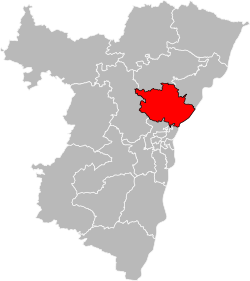Bietlenheim
Bas-Rhin geography stubsCommunes of Bas-RhinPages including recorded pronunciationsPages with French IPA

Bietlenheim (French pronunciation: [bitlənaim] ) is a commune in the Bas-Rhin department in Grand Est in northeastern France.
Excerpt from the Wikipedia article Bietlenheim (License: CC BY-SA 3.0, Authors, Images).Bietlenheim
Rue Principale, Haguenau-Wissembourg
Geographical coordinates (GPS) Address Nearby Places Show on map
Geographical coordinates (GPS)
| Latitude | Longitude |
|---|---|
| N 48.7197 ° | E 7.7822 ° |
Address
Rue Principale
67720 Haguenau-Wissembourg
Grand Est, France
Open on Google Maps










